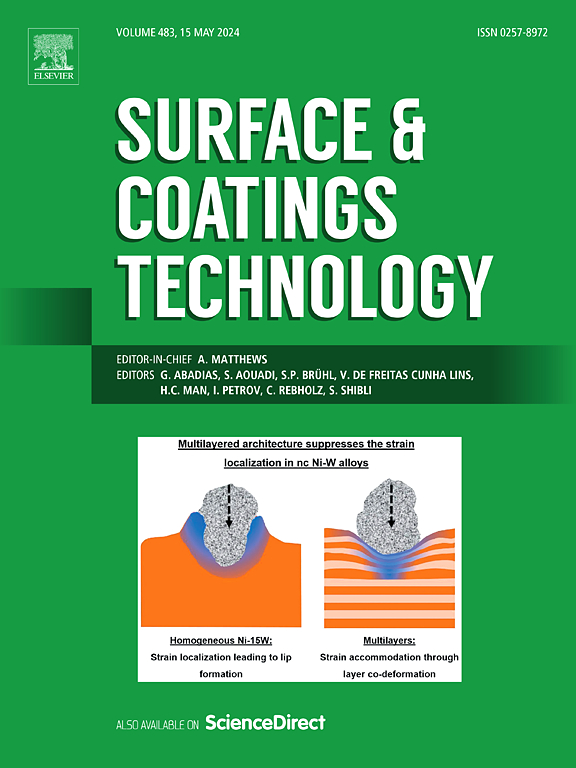生物医学用PVTF薄膜上密度可调ZnO纳米棒阵列的快速合成
IF 5.3
2区 材料科学
Q1 MATERIALS SCIENCE, COATINGS & FILMS
引用次数: 0
摘要
生物材料的纳米拓扑形态在细胞相容性中起着重要的作用。氧化锌纳米棒(ZNR)阵列作为组织工程植入物的涂层,通常用作细胞的抗粘附层,但在调节细胞粘附和增殖等细胞相容性方面的应用相对有限。本研究将ZNR阵列加载到聚偏氟乙烯-三氟乙烯(PVTF)衬底表面,通过高温毛细现象实现熔融PVTF对ZNR的包埋作用。通过调整ZNR阵列的c轴方向可以控制嵌入度,从而可以构建具有不同纳米棒分布密度的PVTF-ZNR复合薄膜。可调节的表面纳米拓扑结构调节骨髓间充质干细胞(BMSCs)的粘附和增殖行为,其中具有低纳米棒分布密度的表面纳米结构有利于骨髓间充质干细胞的扩散和增殖。此外,纳米结构可以在粘附和增殖的早期阶段从表面分离,不再影响细胞行为。复合膜有利于组织再生植入物在植入早期促进细胞粘附和增殖。此外,由于PVTF优异的压电性能,它具有进一步修复的前景。本文章由计算机程序翻译,如有差异,请以英文原文为准。
A facile synthesis of density-tunable ZnO nanorod-array on PVTF film for biomedical application
The nanotopological morphology of biomaterials plays a significant role in cytocompatibility. As a coating for tissue engineering implants, zinc oxide nanorod (ZNR) arrays are usually utilized as anti-adhesion layers for cells with relatively limited applications in regulating cytocompatibility such as cell adhesion and proliferation. In this study, ZNR arrays were loaded onto the surface of the poly (vinylidene fluoride-trifluoroethylene) (PVTF) substrate, and an embedding effect of molten PVTF on ZNR was achieved through high temperature capillary phenomenon. The embedding degree could be controlled by adjusting the C-axis orientation of ZNR arrays, thus allowing the construction of PVTF-ZNR composite films with varying nanorod distribution densities. The tunable surface nanotopology structure regulated the adhesion and proliferation behaviors of bone marrow mesenchymal stem cells (BMSCs), among which the surface nanostructure with a low nanorod distribution density was conducive to the spreading and proliferation of BMSCs. Furthermore, the nanostructure can detach from the surface after the early stage of adhesion and proliferation, ceasing to affect cellular behavior. The composite film is beneficial for tissue regeneration implants to promote cell adhesion and proliferation in early implantation. Additionally, it's promising in further repair due to the excellent piezoelectric property of PVTF.
求助全文
通过发布文献求助,成功后即可免费获取论文全文。
去求助
来源期刊

Surface & Coatings Technology
工程技术-材料科学:膜
CiteScore
10.00
自引率
11.10%
发文量
921
审稿时长
19 days
期刊介绍:
Surface and Coatings Technology is an international archival journal publishing scientific papers on significant developments in surface and interface engineering to modify and improve the surface properties of materials for protection in demanding contact conditions or aggressive environments, or for enhanced functional performance. Contributions range from original scientific articles concerned with fundamental and applied aspects of research or direct applications of metallic, inorganic, organic and composite coatings, to invited reviews of current technology in specific areas. Papers submitted to this journal are expected to be in line with the following aspects in processes, and properties/performance:
A. Processes: Physical and chemical vapour deposition techniques, thermal and plasma spraying, surface modification by directed energy techniques such as ion, electron and laser beams, thermo-chemical treatment, wet chemical and electrochemical processes such as plating, sol-gel coating, anodization, plasma electrolytic oxidation, etc., but excluding painting.
B. Properties/performance: friction performance, wear resistance (e.g., abrasion, erosion, fretting, etc), corrosion and oxidation resistance, thermal protection, diffusion resistance, hydrophilicity/hydrophobicity, and properties relevant to smart materials behaviour and enhanced multifunctional performance for environmental, energy and medical applications, but excluding device aspects.
 求助内容:
求助内容: 应助结果提醒方式:
应助结果提醒方式:


